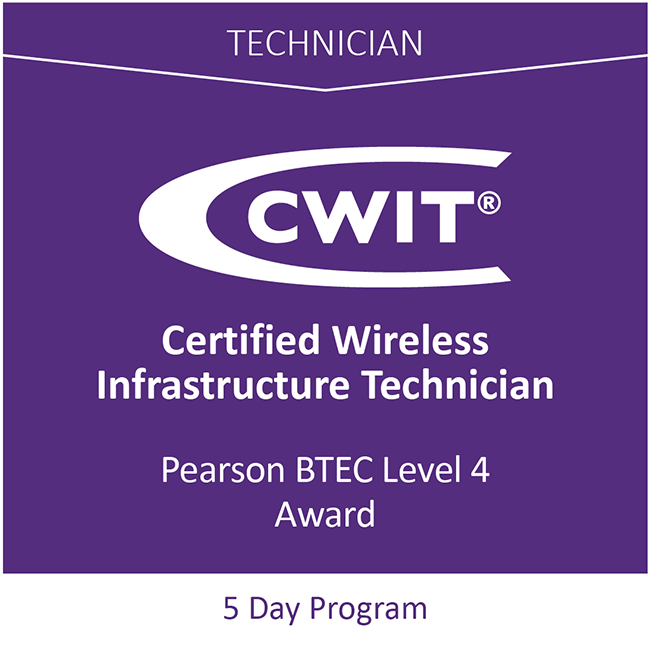

An Award Winning Program - The Certified Wireless Infrastructure Technician (CWIT®) won The Innovation Award 2021 from Network Computing.
Learn how to plan and install a wireless network to facilitate high speed access for smart mobile devices. Using the latest wireless technologies, ensure all users have comprehensive access at all times to benefit from a seamless roaming experience.
The Certified Wireless Infrastructure Technician (CWIT®) is a comprehensive program, made up of 30% theory work, 20% case studies and 50% practical work.
Learners can take their existing network cabling knowledge and skills to the next level by gaining a valuable insight into current and emerging wireless networking technologies used to provide in-building wireless coverage. Methods used for connection to backbone networks also feature with explorations into the principles of microwave radio bearers, fibre systems and cable technologies. Each subject area covers the latest standards and codes of practice and ensures technicians are armed with everything they need to undertake installation projects to the highest possible standards.
Focused practical hands-on sessions are incorporated throughout this program, including a focus on advanced wireless infrastructure installation, troubleshooting, wireless coverage surveys and network testing tools. The organisation and management of site records and wireless system test results through OEM software is also included.
The duration of this program is five days; the content is comprehensive and detailed, allowing network infrastructure professionals to have the potential to add real value to their skills by including these complex areas in their product portfolio. A qualified CWIT® will be undaunted when dealing with escalations and problem resolution within a strategic wireless network project.
On successful completion, learners can demonstrate the highest levels of competency and can feel confident that they possess the very latest technical abilities within these fields of installation and feel confident that they are progressing through The Global Digital Infrastructure Education Framework. They also gain an internationally recognised BTEC Level 4 qualification and CWIT® certification - providing the use of post nominal letters after their name and the use of the official CWIT® logo.
A certified CWIT® also considers the requirements for compliance, having a full understanding of national and international regulations, codes and standards. During the program, learners will be provided a valuable opportunity to access the latest industry standards.
Following this program, you are encouraged to continue your professional development by advancing your knowledge and skills to gain further official certifications and qualifications by progressing through The Global Digital Infrastructure Education Framework which maps education programs to career advancement throughout the network infrastructure and data centre sectors.
The CWIT® program is classroom-based and led by one of CNet’s expert Instructors.
Role of the CWIT® in
- The core layer
- The distribution layer
- The access layer
Regulations, Standards, Codes, Organisations and Forums
- Wireless regulations, standards, codes and organisations
- Wireless trade organisations and forums
- Emerging wireless technologies and related standards
Fundamentals of Wireless Communications
- Electromagnetic Spectrum
- Advantages of the wireless solutions
- RF propagation
- Modulation schemes
Wireless Networking Principles
- Cellular, WLAN, PAN and Microwave technologies
- Femto/Pico/Micro and Macrocells
- WLAN types
- Frequency Bands and Channel Numbers
- Core Networks
- MIMO antennas
- Remote Radio Head (RRH)
- PoE Switches
- Remote Radio Head (RRH)
- PoE Switches
- Self-organising Networks (SON)
- Network and Security Gateways
- Coverage and Capacity 2G, 3G, 4G LTE and 5G NR
- WIFI 4, 5, 6 and 6E
- Optimal positioning of RF units
- LiFi
- Wiring the Wireless Network
Planning for In-Building Installations
- On-site health & safety assessment
- Wireless infrastructure administration & floor plans
- Capacity & Coverage plans arising from use of planning tools
- Ethernet and fibre cable route planning
- Equipment mounting choices and types
- Iteration process – ideal vs. practical choices
- Rack space and equipment connection planning
- PoE and AC/DC planning
- Active and Passive Distributed Antenna Systems
- Convergence of IBW solutions
- The role of Wireless in Smart Cities
In-Building Installations
- Structural support for wall and ceiling RF unit fixings
- Tools used for wall and ceiling fixings
- PPE, steps, ladders, towers used during mounting of RF units
- Installation of PoE switches and servers
- Connection, earthing and AC/DC power
- Testing and connection of Ethernet and optical fibre cables
- Installation of internal RF antenna 1800MHz, 2.4GHz, 5GHz and 6 GHz
- Extending IBW solutions out of the building
In-Building Commissioning
- Powering up switches and servers
- Use of CLI and GUI
- Entry of initial parameters to enable SON
- Testing: RF coverage, cable compliance, handover and provision of service
- Optimisation of RF coverage through physical adjustments
- Documenting test results
Wireless Infrastructure Troubleshooting
- Identification of faulty RF units or PoE devices
- PoE testing
- Coverage testing using test phone
- Typical replacement procedures: RF units, switches, servers
There are three case studies to be completed within the program, one each in support of WLAN, IBW and Cellular wireless infrastructure planning and installation. A multiple choice exam at the end of the program forms the summative assessment.
The Certified Wireless Infrastructure Technician (CWIT®) training program is 5 days in duration.
This program is designed for individuals experienced within the network cabling installation environment wishing to extend their hands-on practical skills, knowledge, qualifications and certifications in relation to generic wireless installation within diverse environments and with aspirations to progress into roles such as:
- Installation Technician
- Commissioning Engineer
- Wireless Network Designer
- Wireless Project Delivery Manager
To attend this program 2-3 years of verifiable experience in a cable or wireless installation role is necessary. Successful completion of the Certified Network Cable Installer (CNCI®) program would be an advantage. If you would like to discuss your experience or suitability for this program please contact us.
Learners are required to have:
- A webcam and microphone enabled laptop with unrestricted wireless internet connectivity and a pre-installed web browser
- A suitable application for reading/annotating PDFs and a suitable application for editing standard office documents such as Microsoft Word, PowerPoint, and Excel
Successful learners will have the knowledge and practical skills to confidently install, test and certify installations in support of Wireless Ethernet and Small Cell applications in the WAN environment and other emerging networking technologies.
- Internationally and industry recognised Pearson BTEC Level 4 Award in Certified Wireless Infrastructure Technician
- Official Certified Wireless Infrastructure Technician (CWIT®) Certification
- Use of the CWIT post nominal title e.g. John Smith CDCSP
- Use of the official CWIT® digital badge
- Use of the CWIT® logo
- Eligibility for an ECS (Electrotechnical Certification Scheme) Digital Support Technician card (only available in the UK)
- Continual Professional Development (CPDs)
- 5 IEEE Continual Education Units (CEUs)
- Enhance technical capability and ability to deliver wireless
network projects - Greater understanding of network architecture and the choice of wireless network components
- Opportunity for personal development leading to enhanced role satisfaction
- Gain an industry recognised qualification and official certification
- Enhance your technical portfolio, leading to greater opportunities when
tendering for projects - Develop business opportunities in technologies that are normally considered
specialised - Realise cost savings by retaining business internally
- Investment in team development improves morale and job satisfaction
leading to greater staff loyalty
- Certified Integrated Infrastructure Technician (CIIT®) – designed for those wishing to extend their technical knowledge, further develop practical skill sets, with an aim to achieve a broader technical level capability, supported by professional qualification and certification.
- Certified Outside Plant Technician (COPT®) – designed for individuals experienced within the network cabling installation environment wishing to extend their hands-on practical skills, knowledge, qualifications and certifications in relation to fibre optic technology and infrastructure in the external environment
- Certified Network Infrastructure Technician (CNIT®) – for individuals within the network cabling installation environment wishing to extend their hands on practical skills, knowledge, qualifications and certifications in relation to cable installation within different environments
- Certified Telecommunications Project Management (CTPM®) – gain the ability to ensure that data centre projects are correctly managed and delivered to meet the business needs.










